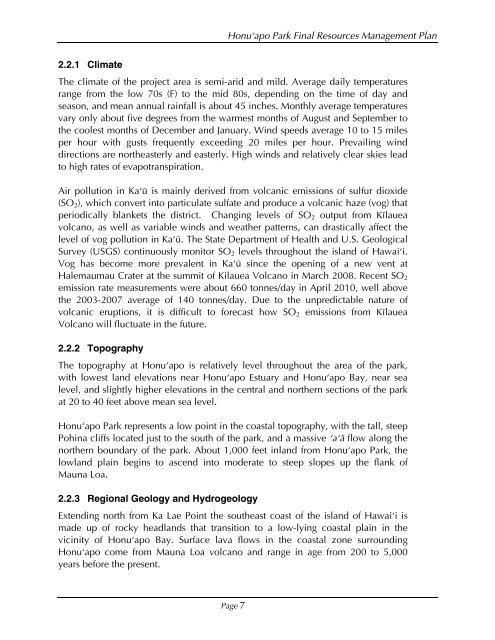Honu'apo Park Resource Management Plan
Honu'apo Park Resource Management Plan
Honu'apo Park Resource Management Plan
Create successful ePaper yourself
Turn your PDF publications into a flip-book with our unique Google optimized e-Paper software.
2.2.1 Climate<br />
Honuÿapo <strong>Park</strong> Final <strong>Resource</strong>s <strong>Management</strong> <strong>Plan</strong><br />
The climate of the project area is semi-arid and mild. Average daily temperatures<br />
range from the low 70s (F) to the mid 80s, depending on the time of day and<br />
season, and mean annual rainfall is about 45 inches. Monthly average temperatures<br />
vary only about five degrees from the warmest months of August and September to<br />
the coolest months of December and January. Wind speeds average 10 to 15 miles<br />
per hour with gusts frequently exceeding 20 miles per hour. Prevailing wind<br />
directions are northeasterly and easterly. High winds and relatively clear skies lead<br />
to high rates of evapotranspiration.<br />
Air pollution in Ka‘ü is mainly derived from volcanic emissions of sulfur dioxide<br />
(SO2), which convert into particulate sulfate and produce a volcanic haze (vog) that<br />
periodically blankets the district. Changing levels of SO2 output from Kïlauea<br />
volcano, as well as variable winds and weather patterns, can drastically affect the<br />
level of vog pollution in Kaÿü. The State Department of Health and U.S. Geological<br />
Survey (USGS) continuously monitor SO2 levels throughout the island of Hawaiÿi.<br />
Vog has become more prevalent in Kaÿü since the opening of a new vent at<br />
Halemaumau Crater at the summit of Kilauea Volcano in March 2008. Recent SO2<br />
emission rate measurements were about 660 tonnes/day in April 2010, well above<br />
the 2003-2007 average of 140 tonnes/day. Due to the unpredictable nature of<br />
volcanic eruptions, it is difficult to forecast how SO2 emissions from Kïlauea<br />
Volcano will fluctuate in the future.<br />
2.2.2 Topography<br />
The topography at Honuÿapo is relatively level throughout the area of the park,<br />
with lowest land elevations near Honuÿapo Estuary and Honuÿapo Bay, near sea<br />
level, and slightly higher elevations in the central and northern sections of the park<br />
at 20 to 40 feet above mean sea level.<br />
Honuÿapo <strong>Park</strong> represents a low point in the coastal topography, with the tall, steep<br />
Pohina cliffs located just to the south of the park, and a massive ÿaÿä flow along the<br />
northern boundary of the park. About 1,000 feet inland from Honuÿapo <strong>Park</strong>, the<br />
lowland plain begins to ascend into moderate to steep slopes up the flank of<br />
Mauna Loa.<br />
2.2.3 Regional Geology and Hydrogeology<br />
Extending north from Ka Lae Point the southeast coast of the island of Hawaiÿi is<br />
made up of rocky headlands that transition to a low-lying coastal plain in the<br />
vicinity of Honuÿapo Bay. Surface lava flows in the coastal zone surrounding<br />
Honuÿapo come from Mauna Loa volcano and range in age from 200 to 5,000<br />
years before the present.<br />
Page 7


